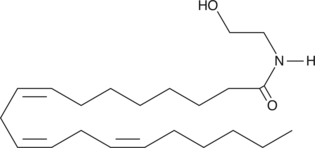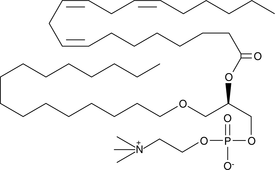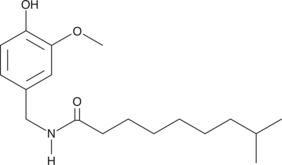Chemicals
Showing 17251–17400 of 41137 results
-
Digitoxin is a cardiac glycoside that has been found in Digitalis and has diverse biological activities.{29469,52442,52443,52444,52445} It inhibits human recombinant α1β1, α2β2, and α3β1 subunit-containing Na+/K+-ATPases with Ki values of 250, 63, and 136 nM, respectively.{29469} Digitoxin inhibits the human-ether-a-go-go (hERG) potassium channel, also known as Kv11.1, in HEK293 cells expressing hERG (IC50 = 11.1 nM).{52442} It enhances developed tension and contractile force in electrically stimulated isolated guinea pig left atrial muscle when used at concentrations of 0.2 and 0.4 µM, respectively.{52443} Dietary administration of digitoxin (~1 mg/kg per day) attenuates congestive heart failure and reduces myocardial hypertrophy in a rat model of myocardial infarction induced by coronary artery ligation.{52444} Digitoxin is also cytotoxic to a panel of 10 human cancer cell lines, including myeloma, lymphoma, and leukemia cancer cells, with IC50 values ranging from 12 to 76 nM.{52445} Formulations containing digitoxin have previously been used in the treatment of congestive heart failure and cardiac arrhythmias.
Brand:CaymanSKU:27825 - 100 mgAvailable on backorder
Digitoxin is a cardiac glycoside that has been found in Digitalis and has diverse biological activities.{29469,52442,52443,52444,52445} It inhibits human recombinant α1β1, α2β2, and α3β1 subunit-containing Na+/K+-ATPases with Ki values of 250, 63, and 136 nM, respectively.{29469} Digitoxin inhibits the human-ether-a-go-go (hERG) potassium channel, also known as Kv11.1, in HEK293 cells expressing hERG (IC50 = 11.1 nM).{52442} It enhances developed tension and contractile force in electrically stimulated isolated guinea pig left atrial muscle when used at concentrations of 0.2 and 0.4 µM, respectively.{52443} Dietary administration of digitoxin (~1 mg/kg per day) attenuates congestive heart failure and reduces myocardial hypertrophy in a rat model of myocardial infarction induced by coronary artery ligation.{52444} Digitoxin is also cytotoxic to a panel of 10 human cancer cell lines, including myeloma, lymphoma, and leukemia cancer cells, with IC50 values ranging from 12 to 76 nM.{52445} Formulations containing digitoxin have previously been used in the treatment of congestive heart failure and cardiac arrhythmias.
Brand:CaymanSKU:27825 - 250 mgAvailable on backorder
Digitoxin is a cardiac glycoside that has been found in Digitalis and has diverse biological activities.{29469,52442,52443,52444,52445} It inhibits human recombinant α1β1, α2β2, and α3β1 subunit-containing Na+/K+-ATPases with Ki values of 250, 63, and 136 nM, respectively.{29469} Digitoxin inhibits the human-ether-a-go-go (hERG) potassium channel, also known as Kv11.1, in HEK293 cells expressing hERG (IC50 = 11.1 nM).{52442} It enhances developed tension and contractile force in electrically stimulated isolated guinea pig left atrial muscle when used at concentrations of 0.2 and 0.4 µM, respectively.{52443} Dietary administration of digitoxin (~1 mg/kg per day) attenuates congestive heart failure and reduces myocardial hypertrophy in a rat model of myocardial infarction induced by coronary artery ligation.{52444} Digitoxin is also cytotoxic to a panel of 10 human cancer cell lines, including myeloma, lymphoma, and leukemia cancer cells, with IC50 values ranging from 12 to 76 nM.{52445} Formulations containing digitoxin have previously been used in the treatment of congestive heart failure and cardiac arrhythmias.
Brand:CaymanSKU:27825 - 500 mgAvailable on backorder
Digoxigenin monodigitoxoside is a Na+/K+-ATPase inhibitor and cardiac glycoside metabolite of digoxin (Item No. 22266).{35125} It has a binding affinity of 0.829 and an inhibitory potency of 1.07 relative to [3H]ouabain in a competitive binding assay using purified lamb Na+/K+-ATPase and for its ATPase activity, respectively.{35127} Digoxigenin monodigitoxoside is selective for the α3β1 isoform over α1β1 and α2β1 (Kds = 31.8, 65, and 35 nM, respectively).{29469} Digoxigenin monodigitoxoside produces a more potent inotropic response in perfused guinea pig hearts than digoxin with 60 and 46% increases in inotropy, respectively.{35125}
Brand:CaymanSKU:21699 -Out of stock
Digoxigenin monodigitoxoside is a Na+/K+-ATPase inhibitor and cardiac glycoside metabolite of digoxin (Item No. 22266).{35125} It has a binding affinity of 0.829 and an inhibitory potency of 1.07 relative to [3H]ouabain in a competitive binding assay using purified lamb Na+/K+-ATPase and for its ATPase activity, respectively.{35127} Digoxigenin monodigitoxoside is selective for the α3β1 isoform over α1β1 and α2β1 (Kds = 31.8, 65, and 35 nM, respectively).{29469} Digoxigenin monodigitoxoside produces a more potent inotropic response in perfused guinea pig hearts than digoxin with 60 and 46% increases in inotropy, respectively.{35125}
Brand:CaymanSKU:21699 -Out of stock
Digoxin is a cardiac glycoside and metabolite of digitoxin that binds to and inhibits the Na+/K+-ATPase in cardiac tissues in an ATP- and Mg2+-dependent manner.{38192} This inhibition results in loss of the transmembrane Na+ gradient, which decreases activity of the Na+/Ca2+ exchanger, increasing intracellular Ca2+ levels, inotropy, and cardiac force.{38193} It increases activity of mitochondrial ATPase and actomyosin ATPase in rat hearts, which is directly correlated with increased myofibrillar contractile strength.{38194} In vivo, digoxin also decreases right atrial pressure and increases cardiac output in a canine model of congestive heart failure produced by pulmonary artery constriction.{38195} Formulations containing digoxin have been used to treat atrial fibrillation.{38196}
Brand:CaymanSKU:22266 -Out of stock
Digoxin is a cardiac glycoside and metabolite of digitoxin that binds to and inhibits the Na+/K+-ATPase in cardiac tissues in an ATP- and Mg2+-dependent manner.{38192} This inhibition results in loss of the transmembrane Na+ gradient, which decreases activity of the Na+/Ca2+ exchanger, increasing intracellular Ca2+ levels, inotropy, and cardiac force.{38193} It increases activity of mitochondrial ATPase and actomyosin ATPase in rat hearts, which is directly correlated with increased myofibrillar contractile strength.{38194} In vivo, digoxin also decreases right atrial pressure and increases cardiac output in a canine model of congestive heart failure produced by pulmonary artery constriction.{38195} Formulations containing digoxin have been used to treat atrial fibrillation.{38196}
Brand:CaymanSKU:22266 -Out of stock
Digoxin is a cardiac glycoside and metabolite of digitoxin that binds to and inhibits the Na+/K+-ATPase in cardiac tissues in an ATP- and Mg2+-dependent manner.{38192} This inhibition results in loss of the transmembrane Na+ gradient, which decreases activity of the Na+/Ca2+ exchanger, increasing intracellular Ca2+ levels, inotropy, and cardiac force.{38193} It increases activity of mitochondrial ATPase and actomyosin ATPase in rat hearts, which is directly correlated with increased myofibrillar contractile strength.{38194} In vivo, digoxin also decreases right atrial pressure and increases cardiac output in a canine model of congestive heart failure produced by pulmonary artery constriction.{38195} Formulations containing digoxin have been used to treat atrial fibrillation.{38196}
Brand:CaymanSKU:22266 -Out of stock
Digoxin is a cardiac glycoside and metabolite of digitoxin that binds to and inhibits the Na+/K+-ATPase in cardiac tissues in an ATP- and Mg2+-dependent manner.{38192} This inhibition results in loss of the transmembrane Na+ gradient, which decreases activity of the Na+/Ca2+ exchanger, increasing intracellular Ca2+ levels, inotropy, and cardiac force.{38193} It increases activity of mitochondrial ATPase and actomyosin ATPase in rat hearts, which is directly correlated with increased myofibrillar contractile strength.{38194} In vivo, digoxin also decreases right atrial pressure and increases cardiac output in a canine model of congestive heart failure produced by pulmonary artery constriction.{38195} Formulations containing digoxin have been used to treat atrial fibrillation.{38196}
Brand:CaymanSKU:22266 -Out of stock
Digoxin-d3 is intended for use as an internal standard for the quantification of digoxin (Item No. 22266) by GC- or LC-MS. Digoxin is a cardiac glycoside and metabolite of digitoxin (Item No. 27825) that binds to and inhibits the Na+/K+-ATPase in cardiac tissues in an ATP- and Mg2+-dependent manner.{38192} This inhibition results in loss of the transmembrane Na+ gradient, which decreases activity of the Na+/Ca2+ exchanger, increasing intracellular Ca2+ levels, inotropy, and cardiac force.{38193} It increases activity of mitochondrial ATPase and actomyosin ATPase in rat hearts, which is directly correlated with increased myofibrillar contractile strength.{38194} In vivo, digoxin also decreases right atrial pressure and increases cardiac output in a canine model of congestive heart failure produced by pulmonary artery constriction.{38195} Formulations containing digoxin have been used to treat atrial fibrillation.{38196}
Brand:CaymanSKU:10010657 - 1 mgAvailable on backorder
Digoxin-d3 is intended for use as an internal standard for the quantification of digoxin (Item No. 22266) by GC- or LC-MS. Digoxin is a cardiac glycoside and metabolite of digitoxin (Item No. 27825) that binds to and inhibits the Na+/K+-ATPase in cardiac tissues in an ATP- and Mg2+-dependent manner.{38192} This inhibition results in loss of the transmembrane Na+ gradient, which decreases activity of the Na+/Ca2+ exchanger, increasing intracellular Ca2+ levels, inotropy, and cardiac force.{38193} It increases activity of mitochondrial ATPase and actomyosin ATPase in rat hearts, which is directly correlated with increased myofibrillar contractile strength.{38194} In vivo, digoxin also decreases right atrial pressure and increases cardiac output in a canine model of congestive heart failure produced by pulmonary artery constriction.{38195} Formulations containing digoxin have been used to treat atrial fibrillation.{38196}
Brand:CaymanSKU:10010657 - 5 mgAvailable on backorder
Digoxin-d3 is intended for use as an internal standard for the quantification of digoxin (Item No. 22266) by GC- or LC-MS. Digoxin is a cardiac glycoside and metabolite of digitoxin (Item No. 27825) that binds to and inhibits the Na+/K+-ATPase in cardiac tissues in an ATP- and Mg2+-dependent manner.{38192} This inhibition results in loss of the transmembrane Na+ gradient, which decreases activity of the Na+/Ca2+ exchanger, increasing intracellular Ca2+ levels, inotropy, and cardiac force.{38193} It increases activity of mitochondrial ATPase and actomyosin ATPase in rat hearts, which is directly correlated with increased myofibrillar contractile strength.{38194} In vivo, digoxin also decreases right atrial pressure and increases cardiac output in a canine model of congestive heart failure produced by pulmonary artery constriction.{38195} Formulations containing digoxin have been used to treat atrial fibrillation.{38196}
Brand:CaymanSKU:10010657 - 500 µgAvailable on backorder
Diheptadecanoin is a diacylglycerol that contains heptadecanoic acid (Item No. 19722) at two positions.
Brand:CaymanSKU:27002 - 100 mgAvailable on backorder
Diheptadecanoin is a diacylglycerol that contains heptadecanoic acid (Item No. 19722) at two positions.
Brand:CaymanSKU:27002 - 250 mgAvailable on backorder
Diheptadecanoin is a diacylglycerol that contains heptadecanoic acid (Item No. 19722) at two positions.
Brand:CaymanSKU:27002 - 50 mgAvailable on backorder
Diheptadecanoin is a diacylglycerol that contains heptadecanoic acid (Item No. 19722) at two positions.
Brand:CaymanSKU:27002 - 500 mgAvailable on backorder
Dihexa is an activator of the hepatocyte growth factor/c-Met (HGF/c-Met) system and an analog of the peptide angiotensin IV.{47455} It binds to HGF (Kd = 65 pM), inhibits HGF dimerization, and enhances activation of c-Met by HGF in HEK293 cells expressing c-Met. It increases the number of dendritic spines formed and increases the mean frequency of miniature excitatory post-synaptic currents (mEPSCs) in dissociated hippocampal neurons, effects that can be blocked by the HGF antagonist Hinge. Dihexa (2 mg/kg, i.p.) completely reverses scopolamine-induced learning deficits in the latency to find the platform and increases the time spent in the target quadrant in the Morris water maze in rats.{47456}
Brand:CaymanSKU:27484 - 10 mgAvailable on backorder
Dihexa is an activator of the hepatocyte growth factor/c-Met (HGF/c-Met) system and an analog of the peptide angiotensin IV.{47455} It binds to HGF (Kd = 65 pM), inhibits HGF dimerization, and enhances activation of c-Met by HGF in HEK293 cells expressing c-Met. It increases the number of dendritic spines formed and increases the mean frequency of miniature excitatory post-synaptic currents (mEPSCs) in dissociated hippocampal neurons, effects that can be blocked by the HGF antagonist Hinge. Dihexa (2 mg/kg, i.p.) completely reverses scopolamine-induced learning deficits in the latency to find the platform and increases the time spent in the target quadrant in the Morris water maze in rats.{47456}
Brand:CaymanSKU:27484 - 25 mgAvailable on backorder
Dihexa is an activator of the hepatocyte growth factor/c-Met (HGF/c-Met) system and an analog of the peptide angiotensin IV.{47455} It binds to HGF (Kd = 65 pM), inhibits HGF dimerization, and enhances activation of c-Met by HGF in HEK293 cells expressing c-Met. It increases the number of dendritic spines formed and increases the mean frequency of miniature excitatory post-synaptic currents (mEPSCs) in dissociated hippocampal neurons, effects that can be blocked by the HGF antagonist Hinge. Dihexa (2 mg/kg, i.p.) completely reverses scopolamine-induced learning deficits in the latency to find the platform and increases the time spent in the target quadrant in the Morris water maze in rats.{47456}
Brand:CaymanSKU:27484 - 5 mgAvailable on backorder
Dihexa is an activator of the hepatocyte growth factor/c-Met (HGF/c-Met) system and an analog of the peptide angiotensin IV.{47455} It binds to HGF (Kd = 65 pM), inhibits HGF dimerization, and enhances activation of c-Met by HGF in HEK293 cells expressing c-Met. It increases the number of dendritic spines formed and increases the mean frequency of miniature excitatory post-synaptic currents (mEPSCs) in dissociated hippocampal neurons, effects that can be blocked by the HGF antagonist Hinge. Dihexa (2 mg/kg, i.p.) completely reverses scopolamine-induced learning deficits in the latency to find the platform and increases the time spent in the target quadrant in the Morris water maze in rats.{47456}
Brand:CaymanSKU:27484 - 50 mgAvailable on backorder
Dihexadecyl phosphate is a negatively-charged synthetic phospholipid that has been used to impart a negative charge to neutral liposomes.{37728} It has also been used in the generation of micelles, liposomes, and other types of artificial membranes, including niosomes for drug delivery.{37729,37730} Formulations containing dihexadecyl phosphate have been used as emulsifying agents in cosmetics.
Brand:CaymanSKU:25727 - 1 gAvailable on backorder
Dihexadecyl phosphate is a negatively-charged synthetic phospholipid that has been used to impart a negative charge to neutral liposomes.{37728} It has also been used in the generation of micelles, liposomes, and other types of artificial membranes, including niosomes for drug delivery.{37729,37730} Formulations containing dihexadecyl phosphate have been used as emulsifying agents in cosmetics.
Brand:CaymanSKU:25727 - 10 gAvailable on backorder
Dihexadecyl phosphate is a negatively-charged synthetic phospholipid that has been used to impart a negative charge to neutral liposomes.{37728} It has also been used in the generation of micelles, liposomes, and other types of artificial membranes, including niosomes for drug delivery.{37729,37730} Formulations containing dihexadecyl phosphate have been used as emulsifying agents in cosmetics.
Brand:CaymanSKU:25727 - 25 gAvailable on backorder
Dihexadecyl phosphate is a negatively-charged synthetic phospholipid that has been used to impart a negative charge to neutral liposomes.{37728} It has also been used in the generation of micelles, liposomes, and other types of artificial membranes, including niosomes for drug delivery.{37729,37730} Formulations containing dihexadecyl phosphate have been used as emulsifying agents in cosmetics.
Brand:CaymanSKU:25727 - 5 gAvailable on backorder
Dihexanoin is a diacylglycerol that contains the saturated short-chain fatty acid hexanoic acid at two positions.
Brand:CaymanSKU:27293 - 100 mgAvailable on backorder
Dihexanoin is a diacylglycerol that contains the saturated short-chain fatty acid hexanoic acid at two positions.
Brand:CaymanSKU:27293 - 25 mgAvailable on backorder
Dihexanoin is a diacylglycerol that contains the saturated short-chain fatty acid hexanoic acid at two positions.
Brand:CaymanSKU:27293 - 250 mgAvailable on backorder
Dihexanoin is a diacylglycerol that contains the saturated short-chain fatty acid hexanoic acid at two positions.
Brand:CaymanSKU:27293 - 50 mgAvailable on backorder
Dihomo-γ-Linolenic Acid (DGLA, 20:3), an elongation product of γ-linolenic acid (18:3), is rapidly metabolized by fatty acid desaturases to produce arachidonic acid (20:4). DGLA is metabolized through the cyclooxygenase pathway to produce 1-series prostaglandins, including PGE1.{2244,10906} In mice, DGLA supplementation in the diet can reduce atopic dermatitis and atherosclerosis.{19739,19738}
Brand:CaymanSKU:90230 - 10 mgAvailable on backorder
Dihomo-γ-Linolenic Acid (DGLA, 20:3), an elongation product of γ-linolenic acid (18:3), is rapidly metabolized by fatty acid desaturases to produce arachidonic acid (20:4). DGLA is metabolized through the cyclooxygenase pathway to produce 1-series prostaglandins, including PGE1.{2244,10906} In mice, DGLA supplementation in the diet can reduce atopic dermatitis and atherosclerosis.{19739,19738}
Brand:CaymanSKU:90230 - 100 mgAvailable on backorder
Dihomo-γ-Linolenic Acid (DGLA, 20:3), an elongation product of γ-linolenic acid (18:3), is rapidly metabolized by fatty acid desaturases to produce arachidonic acid (20:4). DGLA is metabolized through the cyclooxygenase pathway to produce 1-series prostaglandins, including PGE1.{2244,10906} In mice, DGLA supplementation in the diet can reduce atopic dermatitis and atherosclerosis.{19739,19738}
Brand:CaymanSKU:90230 - 50 mgAvailable on backorder
Dihomo-γ-Linolenic Acid (DGLA, 20:3), an elongation product of γ-linolenic acid (18:3), is rapidly metabolized by fatty acid desaturases to produce arachidonic acid (20:4). DGLA is metabolized through the cyclooxygenase pathway to produce 1-series prostaglandins, including PGE1.{2244,10906} In mice, DGLA supplementation in the diet can reduce atopic dermatitis and atherosclerosis.{19739,19738}
Brand:CaymanSKU:90230 - 500 mgAvailable on backorder
Dihomo-γ-linolenic acid (DGLA) is a metabolite produced by chain elongation of the essential fatty acid γ-linolenic acid. Ethyl DGLA is an esterified version of the free acid which is less water soluble, but more amenable for the formulation of DGLA-containing diets and dietary supplements. DGLA has been advanced as a possible treatment for various inflammatory disorders.{2361,1398} Evening primrose oil is a DGLA-rich nutraceutical which has been advocated for such uses.
Brand:CaymanSKU:90236 - 10 mgAvailable on backorder
Dihomo-γ-linolenic acid (DGLA) is a metabolite produced by chain elongation of the essential fatty acid γ-linolenic acid. Ethyl DGLA is an esterified version of the free acid which is less water soluble, but more amenable for the formulation of DGLA-containing diets and dietary supplements. DGLA has been advanced as a possible treatment for various inflammatory disorders.{2361,1398} Evening primrose oil is a DGLA-rich nutraceutical which has been advocated for such uses.
Brand:CaymanSKU:90236 - 100 mgAvailable on backorder
Dihomo-γ-linolenic acid (DGLA) is a metabolite produced by chain elongation of the essential fatty acid γ-linolenic acid. Ethyl DGLA is an esterified version of the free acid which is less water soluble, but more amenable for the formulation of DGLA-containing diets and dietary supplements. DGLA has been advanced as a possible treatment for various inflammatory disorders.{2361,1398} Evening primrose oil is a DGLA-rich nutraceutical which has been advocated for such uses.
Brand:CaymanSKU:90236 - 50 mgAvailable on backorder
Dihomo-γ-linolenic acid (DGLA) is a metabolite produced by chain elongation of the essential fatty acid γ-linolenic acid. Ethyl DGLA is an esterified version of the free acid which is less water soluble, but more amenable for the formulation of DGLA-containing diets and dietary supplements. DGLA has been advanced as a possible treatment for various inflammatory disorders.{2361,1398} Evening primrose oil is a DGLA-rich nutraceutical which has been advocated for such uses.
Brand:CaymanSKU:90236 - 500 mgAvailable on backorder
Dihomo-γ-linolenic acid (DGLA) is a metabolite produced by chain elongation of the essential fatty acid γ-linolenic acid. Methyl DGLA is an esterified version of the free acid which is less water soluble, but more ammenable for the formulation of DGLA-containing diets and dietary supplements. DGLA has been advanced as a possible treatment for various inflammatory disorders.{1398,2361} Evening primrose oil is a DGLA-rich nutraceutical which has been advocated for such uses.
Brand:CaymanSKU:10006580 - 10 mgAvailable on backorder
Dihomo-γ-linolenic acid (DGLA) is a metabolite produced by chain elongation of the essential fatty acid γ-linolenic acid. Methyl DGLA is an esterified version of the free acid which is less water soluble, but more ammenable for the formulation of DGLA-containing diets and dietary supplements. DGLA has been advanced as a possible treatment for various inflammatory disorders.{1398,2361} Evening primrose oil is a DGLA-rich nutraceutical which has been advocated for such uses.
Brand:CaymanSKU:10006580 - 100 mgAvailable on backorder
Dihomo-γ-linolenic acid (DGLA) is a metabolite produced by chain elongation of the essential fatty acid γ-linolenic acid. Methyl DGLA is an esterified version of the free acid which is less water soluble, but more ammenable for the formulation of DGLA-containing diets and dietary supplements. DGLA has been advanced as a possible treatment for various inflammatory disorders.{1398,2361} Evening primrose oil is a DGLA-rich nutraceutical which has been advocated for such uses.
Brand:CaymanSKU:10006580 - 50 mgAvailable on backorder
Dihomo-γ-Linolenic Acid-d6 (DGLA-d6) contains six deuterium atoms at the 8, 9, 11, 12, 14, and 15 positions. It is intended for use as an internal standard for the quantification of DGLA by GC- or LC-mass spectrometry. Dihomo-γ-Linolenic Acid (DGLA, 20:3), an elongation product of γ-linolenic acid (18:3), is rapidly metabolized by fatty acid desaturases to produce arachidonic acid (20:4). DGLA is metabolized through the cyclooxygenase pathway to produce 1-series prostaglandins, (PGs), including PGE1.{2244,10906} In mice, DGLA supplementation in the diet can reduce atopic dermatitis and atherosclerosis.{19739,19738}
Brand:CaymanSKU:10458 - 1 mgAvailable on backorder
Dihomo-γ-Linolenic Acid-d6 (DGLA-d6) contains six deuterium atoms at the 8, 9, 11, 12, 14, and 15 positions. It is intended for use as an internal standard for the quantification of DGLA by GC- or LC-mass spectrometry. Dihomo-γ-Linolenic Acid (DGLA, 20:3), an elongation product of γ-linolenic acid (18:3), is rapidly metabolized by fatty acid desaturases to produce arachidonic acid (20:4). DGLA is metabolized through the cyclooxygenase pathway to produce 1-series prostaglandins, (PGs), including PGE1.{2244,10906} In mice, DGLA supplementation in the diet can reduce atopic dermatitis and atherosclerosis.{19739,19738}
Brand:CaymanSKU:10458 - 100 µgAvailable on backorder
Dihomo-γ-Linolenic Acid-d6 (DGLA-d6) contains six deuterium atoms at the 8, 9, 11, 12, 14, and 15 positions. It is intended for use as an internal standard for the quantification of DGLA by GC- or LC-mass spectrometry. Dihomo-γ-Linolenic Acid (DGLA, 20:3), an elongation product of γ-linolenic acid (18:3), is rapidly metabolized by fatty acid desaturases to produce arachidonic acid (20:4). DGLA is metabolized through the cyclooxygenase pathway to produce 1-series prostaglandins, (PGs), including PGE1.{2244,10906} In mice, DGLA supplementation in the diet can reduce atopic dermatitis and atherosclerosis.{19739,19738}
Brand:CaymanSKU:10458 - 5 mgAvailable on backorder
Dihomo-γ-Linolenic Acid-d6 (DGLA-d6) contains six deuterium atoms at the 8, 9, 11, 12, 14, and 15 positions. It is intended for use as an internal standard for the quantification of DGLA by GC- or LC-mass spectrometry. Dihomo-γ-Linolenic Acid (DGLA, 20:3), an elongation product of γ-linolenic acid (18:3), is rapidly metabolized by fatty acid desaturases to produce arachidonic acid (20:4). DGLA is metabolized through the cyclooxygenase pathway to produce 1-series prostaglandins, (PGs), including PGE1.{2244,10906} In mice, DGLA supplementation in the diet can reduce atopic dermatitis and atherosclerosis.{19739,19738}
Brand:CaymanSKU:10458 - 500 µgAvailable on backorder
Dihomo-γ-linolenoyl ethanolamide is an endocannabinoid containing dihomo-γ-linoleate in place of the arachidonate moiety of AEA. Dihomo-γ-linolenoyl ethanolamide binds to recombinant human CB1 and CB2 receptors with Ki values of 857 and 598 nM, respectively.{5240} Its specific role and relative importance as a cannabinergic neurotransmitter has not been elucidated.{1172}
Brand:CaymanSKU:90235 - 10 mgAvailable on backorder
Dihomo-γ-linolenoyl ethanolamide is an endocannabinoid containing dihomo-γ-linoleate in place of the arachidonate moiety of AEA. Dihomo-γ-linolenoyl ethanolamide binds to recombinant human CB1 and CB2 receptors with Ki values of 857 and 598 nM, respectively.{5240} Its specific role and relative importance as a cannabinergic neurotransmitter has not been elucidated.{1172}
Brand:CaymanSKU:90235 - 100 mgAvailable on backorder
Dihomo-γ-linolenoyl ethanolamide is an endocannabinoid containing dihomo-γ-linoleate in place of the arachidonate moiety of AEA. Dihomo-γ-linolenoyl ethanolamide binds to recombinant human CB1 and CB2 receptors with Ki values of 857 and 598 nM, respectively.{5240} Its specific role and relative importance as a cannabinergic neurotransmitter has not been elucidated.{1172}
Brand:CaymanSKU:90235 - 5 mgAvailable on backorder
Dihomo-γ-linolenoyl ethanolamide is an endocannabinoid containing dihomo-γ-linoleate in place of the arachidonate moiety of AEA. Dihomo-γ-linolenoyl ethanolamide binds to recombinant human CB1 and CB2 receptors with Ki values of 857 and 598 nM, respectively.{5240} Its specific role and relative importance as a cannabinergic neurotransmitter has not been elucidated.{1172}
Brand:CaymanSKU:90235 - 50 mgAvailable on backorder
Dihomo-γ-linolenoyl PAF C-16 is a PAF analog which contains dihomo-γ-linolenoate at the sn-2 position rather than the acetate moiety found in PAF C-16. The biological activities of dihomo-γ-linolenoyl PAF C-16 are not known at present, but may be similar to arachidonoyl PAF C-16 (Item No. 60904).
Brand:CaymanSKU:60901 - 1 mgAvailable on backorder
Dihomo-γ-linolenoyl PAF C-16 is a PAF analog which contains dihomo-γ-linolenoate at the sn-2 position rather than the acetate moiety found in PAF C-16. The biological activities of dihomo-γ-linolenoyl PAF C-16 are not known at present, but may be similar to arachidonoyl PAF C-16 (Item No. 60904).
Brand:CaymanSKU:60901 - 10 mgAvailable on backorder
Dihomo-γ-linolenoyl PAF C-16 is a PAF analog which contains dihomo-γ-linolenoate at the sn-2 position rather than the acetate moiety found in PAF C-16. The biological activities of dihomo-γ-linolenoyl PAF C-16 are not known at present, but may be similar to arachidonoyl PAF C-16 (Item No. 60904).
Brand:CaymanSKU:60901 - 25 mgAvailable on backorder
Dihomo-γ-linolenoyl PAF C-16 is a PAF analog which contains dihomo-γ-linolenoate at the sn-2 position rather than the acetate moiety found in PAF C-16. The biological activities of dihomo-γ-linolenoyl PAF C-16 are not known at present, but may be similar to arachidonoyl PAF C-16 (Item No. 60904).
Brand:CaymanSKU:60901 - 5 mgAvailable on backorder
Dihydro montelukast is a potential impurity found in commercial montelukast preparations. Montelukast (sodium salt) (Item No. 10008318) is a potent and selective cysteinyl leukotriene 1 (CysLT1) receptor antagonist. Formulations containing montelukast are used for the treatment of asthma as well as for the symptoms associated with allergic rhinitis.{6475,6685,14084,14106}
Brand:CaymanSKU:22374 -Out of stock
Dihydro montelukast is a potential impurity found in commercial montelukast preparations. Montelukast (sodium salt) (Item No. 10008318) is a potent and selective cysteinyl leukotriene 1 (CysLT1) receptor antagonist. Formulations containing montelukast are used for the treatment of asthma as well as for the symptoms associated with allergic rhinitis.{6475,6685,14084,14106}
Brand:CaymanSKU:22374 -Out of stock
Dihydroaeruginoic acid is an antibiotic originally isolated from P. fluorescens.{39828} It has antimicrobial activity in a disc assay against R. solani, P. ultimum, B. cinera, S. rolfsii, C. gloeosporioide, F. oxysporum, and S. tritici fungi as well as B. subtilis, E. herbicola, and S. albus bacteria when used at a concentration of 200 μg/disc.
Brand:CaymanSKU:25514 - 25 mgAvailable on backorder
Dihydroaeruginoic acid is an antibiotic originally isolated from P. fluorescens.{39828} It has antimicrobial activity in a disc assay against R. solani, P. ultimum, B. cinera, S. rolfsii, C. gloeosporioide, F. oxysporum, and S. tritici fungi as well as B. subtilis, E. herbicola, and S. albus bacteria when used at a concentration of 200 μg/disc.
Brand:CaymanSKU:25514 - 5 mgAvailable on backorder
Dihydroartemisinic acid is a biosynthetic precursor to the antimalarial agent artemisinin (Item No. 11816) and an intermediate in the synthesis of artemisinin from artemisinic acid (Item No. 25059).{43473,43472}
Brand:CaymanSKU:25142 - 1 mgAvailable on backorder
Dihydroartemisinic acid is a biosynthetic precursor to the antimalarial agent artemisinin (Item No. 11816) and an intermediate in the synthesis of artemisinin from artemisinic acid (Item No. 25059).{43473,43472}
Brand:CaymanSKU:25142 - 10 mgAvailable on backorder
Dihydroartemisinic acid is a biosynthetic precursor to the antimalarial agent artemisinin (Item No. 11816) and an intermediate in the synthesis of artemisinin from artemisinic acid (Item No. 25059).{43473,43472}
Brand:CaymanSKU:25142 - 25 mgAvailable on backorder
Dihydroartemisinic acid is a biosynthetic precursor to the antimalarial agent artemisinin (Item No. 11816) and an intermediate in the synthesis of artemisinin from artemisinic acid (Item No. 25059).{43473,43472}
Brand:CaymanSKU:25142 - 5 mgAvailable on backorder
Dihydroartemisinin is an active metabolite of the antimalarial drugs artemether (Item No. 11815) and artesunate (Item No. 11817).{26533} It is often used as part of an artemisinin combination therapy with piperaquine.{28281,26531,26532}
Brand:CaymanSKU:19846 -Available on backorder
Dihydroartemisinin is an active metabolite of the antimalarial drugs artemether (Item No. 11815) and artesunate (Item No. 11817).{26533} It is often used as part of an artemisinin combination therapy with piperaquine.{28281,26531,26532}
Brand:CaymanSKU:19846 -Available on backorder
Dihydroartemisinin is an active metabolite of the antimalarial drugs artemether (Item No. 11815) and artesunate (Item No. 11817).{26533} It is often used as part of an artemisinin combination therapy with piperaquine.{28281,26531,26532}
Brand:CaymanSKU:19846 -Available on backorder
Dihydroartemisinin is an active metabolite of the antimalarial drugs artemether (Item No. 11815) and artesunate (Item No. 11817).{26533} It is often used as part of an artemisinin combination therapy with piperaquine.{28281,26531,26532}
Brand:CaymanSKU:19846 -Available on backorder
Dihydrocaffeic acid is a polyphenol that has diverse biological activities, including antioxidant, neuroprotective, and enzyme inhibitory properties.{52015,52016} Dihydrocaffeic acid scavenges ABTS (Item No. 27317; IC50 = 81.86 μg/ml) and 2,2-diphenyl-1-picrylhydrazyl (DPPH; Item No. 14805; IC50 = 192.86 μg/ml) radicals and increases the survival of RGC-5 mouse retinal ganglion cells under hypoxic conditions and in the presence of S-nitroso-N-acetyl-D,L-penicillamine (SNAP; Item No. 82250) in a concentration-dependent manner.{52015} It also decreases endothelial nitric oxide synthase (eNOS) activity in EA.hy926 human endothelial cells in a concentration-dependent manner.{52017} In vivo, dihydrocaffeic acid (30 mg/kg) decreases infarct size in a rat model of transient ischemia induced by middle cerebral artery occlusion (MCAO).{52016}
Brand:CaymanSKU:28390 - 10 gAvailable on backorder
Dihydrocaffeic acid is a polyphenol that has diverse biological activities, including antioxidant, neuroprotective, and enzyme inhibitory properties.{52015,52016} Dihydrocaffeic acid scavenges ABTS (Item No. 27317; IC50 = 81.86 μg/ml) and 2,2-diphenyl-1-picrylhydrazyl (DPPH; Item No. 14805; IC50 = 192.86 μg/ml) radicals and increases the survival of RGC-5 mouse retinal ganglion cells under hypoxic conditions and in the presence of S-nitroso-N-acetyl-D,L-penicillamine (SNAP; Item No. 82250) in a concentration-dependent manner.{52015} It also decreases endothelial nitric oxide synthase (eNOS) activity in EA.hy926 human endothelial cells in a concentration-dependent manner.{52017} In vivo, dihydrocaffeic acid (30 mg/kg) decreases infarct size in a rat model of transient ischemia induced by middle cerebral artery occlusion (MCAO).{52016}
Brand:CaymanSKU:28390 - 25 gAvailable on backorder
Dihydrocaffeic acid is a polyphenol that has diverse biological activities, including antioxidant, neuroprotective, and enzyme inhibitory properties.{52015,52016} Dihydrocaffeic acid scavenges ABTS (Item No. 27317; IC50 = 81.86 μg/ml) and 2,2-diphenyl-1-picrylhydrazyl (DPPH; Item No. 14805; IC50 = 192.86 μg/ml) radicals and increases the survival of RGC-5 mouse retinal ganglion cells under hypoxic conditions and in the presence of S-nitroso-N-acetyl-D,L-penicillamine (SNAP; Item No. 82250) in a concentration-dependent manner.{52015} It also decreases endothelial nitric oxide synthase (eNOS) activity in EA.hy926 human endothelial cells in a concentration-dependent manner.{52017} In vivo, dihydrocaffeic acid (30 mg/kg) decreases infarct size in a rat model of transient ischemia induced by middle cerebral artery occlusion (MCAO).{52016}
Brand:CaymanSKU:28390 - 5 gAvailable on backorder
Dihydrocaffeic acid is a polyphenol that has diverse biological activities, including antioxidant, neuroprotective, and enzyme inhibitory properties.{52015,52016} Dihydrocaffeic acid scavenges ABTS (Item No. 27317; IC50 = 81.86 μg/ml) and 2,2-diphenyl-1-picrylhydrazyl (DPPH; Item No. 14805; IC50 = 192.86 μg/ml) radicals and increases the survival of RGC-5 mouse retinal ganglion cells under hypoxic conditions and in the presence of S-nitroso-N-acetyl-D,L-penicillamine (SNAP; Item No. 82250) in a concentration-dependent manner.{52015} It also decreases endothelial nitric oxide synthase (eNOS) activity in EA.hy926 human endothelial cells in a concentration-dependent manner.{52017} In vivo, dihydrocaffeic acid (30 mg/kg) decreases infarct size in a rat model of transient ischemia induced by middle cerebral artery occlusion (MCAO).{52016}
Brand:CaymanSKU:28390 - 50 gAvailable on backorder
Capsaicin is the primary active component of the heat and pain-eliciting lipid soluble fraction of the Capsicum pepper.{10293} Capsaicin is found in natural hot pepper extracts along with a number of impurities, including dihydrocapsaicin and several lesser impurities. Separation by HPLC is required in order to obtain pure dihydrocapsaicin.{10294} Dihydrocapsaicin is a terpene alkaloid that has been found in Capsicum and has diverse biological activities.{57050,57051,57052} It is active against E. faecalis, B. subtilis, S. aureus, P. aeruginosa, K. pneumoniae, E. coli, and C. albicans (MICs = 0.6-10 µg/ml).{57050} Dihydrocapsaicin scavenges 2,2-diphenyl-1-picrylhydrazyl (DPPH; Item No. 14805) and ABTS (Item No. 27317) radicals in cell-free assays. It increases LC3-II, a marker of autophagy, and catalase levels and reduces reactive oxygen species (ROS) production in normal WI38 lung fibroblasts and H1299, but not A549 or H460, lung cancer cells when used at a concentration of 200 µM.{57051} Dihydrocapsaicin (0.5 mg/kg, i.p.) induces cortical and systemic hypothermia and reduces infarct volume in a rat model of ischemia-reperfusion injury induced by middle cerebral artery occlusion (MCAO).{57052}
Brand:CaymanSKU:92355 - 10 mgAvailable on backorder
Capsaicin is the primary active component of the heat and pain-eliciting lipid soluble fraction of the Capsicum pepper.{10293} Capsaicin is found in natural hot pepper extracts along with a number of impurities, including dihydrocapsaicin and several lesser impurities. Separation by HPLC is required in order to obtain pure dihydrocapsaicin.{10294} Dihydrocapsaicin is a terpene alkaloid that has been found in Capsicum and has diverse biological activities.{57050,57051,57052} It is active against E. faecalis, B. subtilis, S. aureus, P. aeruginosa, K. pneumoniae, E. coli, and C. albicans (MICs = 0.6-10 µg/ml).{57050} Dihydrocapsaicin scavenges 2,2-diphenyl-1-picrylhydrazyl (DPPH; Item No. 14805) and ABTS (Item No. 27317) radicals in cell-free assays. It increases LC3-II, a marker of autophagy, and catalase levels and reduces reactive oxygen species (ROS) production in normal WI38 lung fibroblasts and H1299, but not A549 or H460, lung cancer cells when used at a concentration of 200 µM.{57051} Dihydrocapsaicin (0.5 mg/kg, i.p.) induces cortical and systemic hypothermia and reduces infarct volume in a rat model of ischemia-reperfusion injury induced by middle cerebral artery occlusion (MCAO).{57052}
Brand:CaymanSKU:92355 - 100 mgAvailable on backorder
Capsaicin is the primary active component of the heat and pain-eliciting lipid soluble fraction of the Capsicum pepper.{10293} Capsaicin is found in natural hot pepper extracts along with a number of impurities, including dihydrocapsaicin and several lesser impurities. Separation by HPLC is required in order to obtain pure dihydrocapsaicin.{10294} Dihydrocapsaicin is a terpene alkaloid that has been found in Capsicum and has diverse biological activities.{57050,57051,57052} It is active against E. faecalis, B. subtilis, S. aureus, P. aeruginosa, K. pneumoniae, E. coli, and C. albicans (MICs = 0.6-10 µg/ml).{57050} Dihydrocapsaicin scavenges 2,2-diphenyl-1-picrylhydrazyl (DPPH; Item No. 14805) and ABTS (Item No. 27317) radicals in cell-free assays. It increases LC3-II, a marker of autophagy, and catalase levels and reduces reactive oxygen species (ROS) production in normal WI38 lung fibroblasts and H1299, but not A549 or H460, lung cancer cells when used at a concentration of 200 µM.{57051} Dihydrocapsaicin (0.5 mg/kg, i.p.) induces cortical and systemic hypothermia and reduces infarct volume in a rat model of ischemia-reperfusion injury induced by middle cerebral artery occlusion (MCAO).{57052}
Brand:CaymanSKU:92355 - 5 mgAvailable on backorder
Capsaicin is the primary active component of the heat and pain-eliciting lipid soluble fraction of the Capsicum pepper.{10293} Capsaicin is found in natural hot pepper extracts along with a number of impurities, including dihydrocapsaicin and several lesser impurities. Separation by HPLC is required in order to obtain pure dihydrocapsaicin.{10294} Dihydrocapsaicin is a terpene alkaloid that has been found in Capsicum and has diverse biological activities.{57050,57051,57052} It is active against E. faecalis, B. subtilis, S. aureus, P. aeruginosa, K. pneumoniae, E. coli, and C. albicans (MICs = 0.6-10 µg/ml).{57050} Dihydrocapsaicin scavenges 2,2-diphenyl-1-picrylhydrazyl (DPPH; Item No. 14805) and ABTS (Item No. 27317) radicals in cell-free assays. It increases LC3-II, a marker of autophagy, and catalase levels and reduces reactive oxygen species (ROS) production in normal WI38 lung fibroblasts and H1299, but not A549 or H460, lung cancer cells when used at a concentration of 200 µM.{57051} Dihydrocapsaicin (0.5 mg/kg, i.p.) induces cortical and systemic hypothermia and reduces infarct volume in a rat model of ischemia-reperfusion injury induced by middle cerebral artery occlusion (MCAO).{57052}
Brand:CaymanSKU:92355 - 50 mgAvailable on backorder
Dihydrochelerythrine is a benzophenanthridine alkaloid that has been found in Bocconia arborea and has diverse biological activities.{54051,54052,54053} It is active against S. aureus, S. faecalis, and C. albicans (MIC = 1.87 μg/ml for all).{54051} Dihydrochelerythrine inhibits secretion of the hepatitis B virus (HBV) antigens HBsAg and HBeAg from HepG2 2.2.15 cells (IC50s = 50s = 1.4, 0.4, and 3.5 μM, respectively).{54053}
Brand:CaymanSKU:30118 - 1 mgAvailable on backorder
Dihydrochelerythrine is a benzophenanthridine alkaloid that has been found in Bocconia arborea and has diverse biological activities.{54051,54052,54053} It is active against S. aureus, S. faecalis, and C. albicans (MIC = 1.87 μg/ml for all).{54051} Dihydrochelerythrine inhibits secretion of the hepatitis B virus (HBV) antigens HBsAg and HBeAg from HepG2 2.2.15 cells (IC50s = 50s = 1.4, 0.4, and 3.5 μM, respectively).{54053}
Brand:CaymanSKU:30118 - 10 mgAvailable on backorder
Dihydrochelerythrine is a benzophenanthridine alkaloid that has been found in Bocconia arborea and has diverse biological activities.{54051,54052,54053} It is active against S. aureus, S. faecalis, and C. albicans (MIC = 1.87 μg/ml for all).{54051} Dihydrochelerythrine inhibits secretion of the hepatitis B virus (HBV) antigens HBsAg and HBeAg from HepG2 2.2.15 cells (IC50s = 50s = 1.4, 0.4, and 3.5 μM, respectively).{54053}
Brand:CaymanSKU:30118 - 25 mgAvailable on backorder
Dihydrochelerythrine is a benzophenanthridine alkaloid that has been found in Bocconia arborea and has diverse biological activities.{54051,54052,54053} It is active against S. aureus, S. faecalis, and C. albicans (MIC = 1.87 μg/ml for all).{54051} Dihydrochelerythrine inhibits secretion of the hepatitis B virus (HBV) antigens HBsAg and HBeAg from HepG2 2.2.15 cells (IC50s = 50s = 1.4, 0.4, and 3.5 μM, respectively).{54053}
Brand:CaymanSKU:30118 - 5 mgAvailable on backorder
Dihydrochlamydocin is a cyclic tetrapeptide with putative histone deacetylase (HDAC) inhibitory activity. Naturally derived cyclic tetrapeptides and their synthetic analogs have demonstrated potent antiparasitic and phytotoxic activity by inhibiting HDACs.{33542,33543}
Brand:CaymanSKU:21614 -Out of stock
Dihydrochlamydocin is a cyclic tetrapeptide with putative histone deacetylase (HDAC) inhibitory activity. Naturally derived cyclic tetrapeptides and their synthetic analogs have demonstrated potent antiparasitic and phytotoxic activity by inhibiting HDACs.{33542,33543}
Brand:CaymanSKU:21614 -Out of stock
Dihydrocytochalasin B (DCB) is a member of the cytochalasin mycotoxin family that inhibits actin assembly.{38141} It blocks cleavage furrow formation and cytokinesis in synchronous HeLa cells at a concentration of 10 μM. DCB induces tetraploidy and arrests the cell cycle indefinitely in the G1 phase in REF-52 cells.{38143} It also increases the drug sensitivity of multidrug resistant SKVLB1 cells to paclitaxel (Item No. 10461) and doxorubicin (Item No. 15007) in vitro.{38142}
Brand:CaymanSKU:20845 -Out of stock
Dihydrocytochalasin B (DCB) is a member of the cytochalasin mycotoxin family that inhibits actin assembly.{38141} It blocks cleavage furrow formation and cytokinesis in synchronous HeLa cells at a concentration of 10 μM. DCB induces tetraploidy and arrests the cell cycle indefinitely in the G1 phase in REF-52 cells.{38143} It also increases the drug sensitivity of multidrug resistant SKVLB1 cells to paclitaxel (Item No. 10461) and doxorubicin (Item No. 15007) in vitro.{38142}
Brand:CaymanSKU:20845 -Out of stock
Dihydrocytochalasin B (DCB) is a member of the cytochalasin mycotoxin family that inhibits actin assembly.{38141} It blocks cleavage furrow formation and cytokinesis in synchronous HeLa cells at a concentration of 10 μM. DCB induces tetraploidy and arrests the cell cycle indefinitely in the G1 phase in REF-52 cells.{38143} It also increases the drug sensitivity of multidrug resistant SKVLB1 cells to paclitaxel (Item No. 10461) and doxorubicin (Item No. 15007) in vitro.{38142}
Brand:CaymanSKU:20845 -Out of stock
Daidzein (Item No. 10005166) is an isoflavonoid phytoestrogenic compound found in soybeans, pea pods, clover, kudzu, and other legumes. Dihydrodaidzein is an active, estrogenic metabolite of daidzein.{30095} It has vasodilatory action on rat isolated aortic rings at 1 µg/ml.{30094} It stimulates the estrogen receptor-dependent growth of breast cancer MCF-7 cells at micromolar concentrations.{30096} Dihydrodaidzein is produced by the metabolism of daidzein in colonic bacteria and may be further metabolized to various bioactive compounds, including equol (Item No. 13184).{30097,30098}
Brand:CaymanSKU:-Available on backorder

![A Na+/K+-ATPase inhibitor; cardiac glycoside metabolite of digoxin; has a binding affinity of 0.829 relative to [3H]ouabain; has an inhibitory potency of 1.07 relative to [3H]ouabain for its ATPase activity; selective for the α3β1 isoform over α1β1 and α2β1 (Kds = 31.8](https://interpriseusa.com/wp-content/uploads/2021/06/21699.png)





















